HiBy FD5 - Analogue and Powerful
Howdy, folks! I have been using the desktop DAC + amp combo from HiBy, the FD5, for over 4 months now, and I think this device has been flying under the radar of most audiophiles. Let’s talk about it and how it fits within my setup and preference, which revolves around sensitive IEMs rather than power-hungry planar headphones.
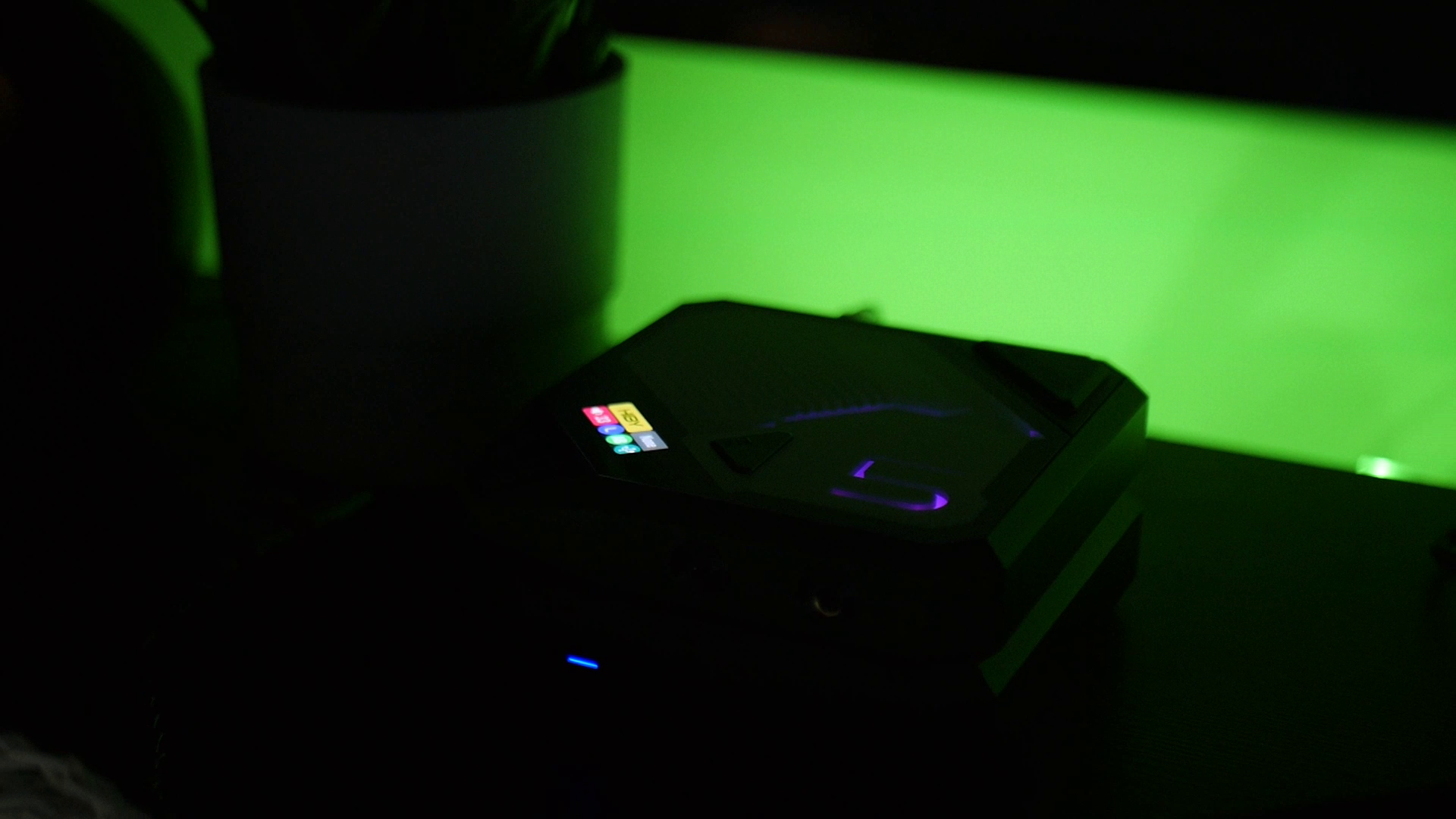
Preambles
- In this review, I use the term “source” to denote a DAC+amp combo for brevity and convenience.
- Sources do not make sounds. Therefore, when I say sources “sound” a certain way, I talk about the change they make to my IEMs and earphones.
- I want my music to be crisp, clear, well-separated and form a 3D soundstage around my head. Sources that intensify those characteristics of my IEMs are considered “better”.
- The unit used for this review was a sample provided by HiBy (Thank you!). The unit is retailed for $429 and can be found on HiBy web store (non-affiliated link).
General Information
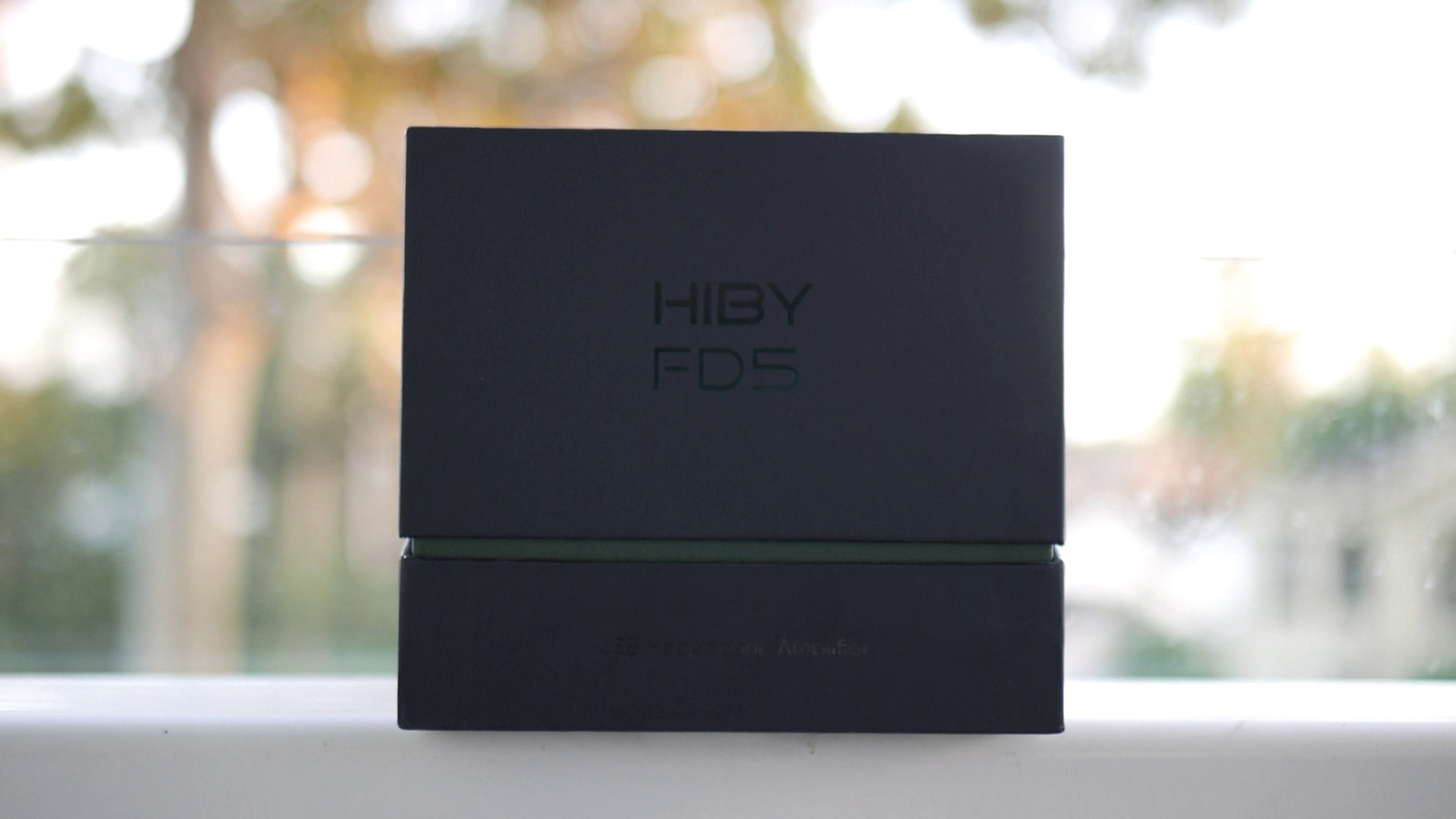
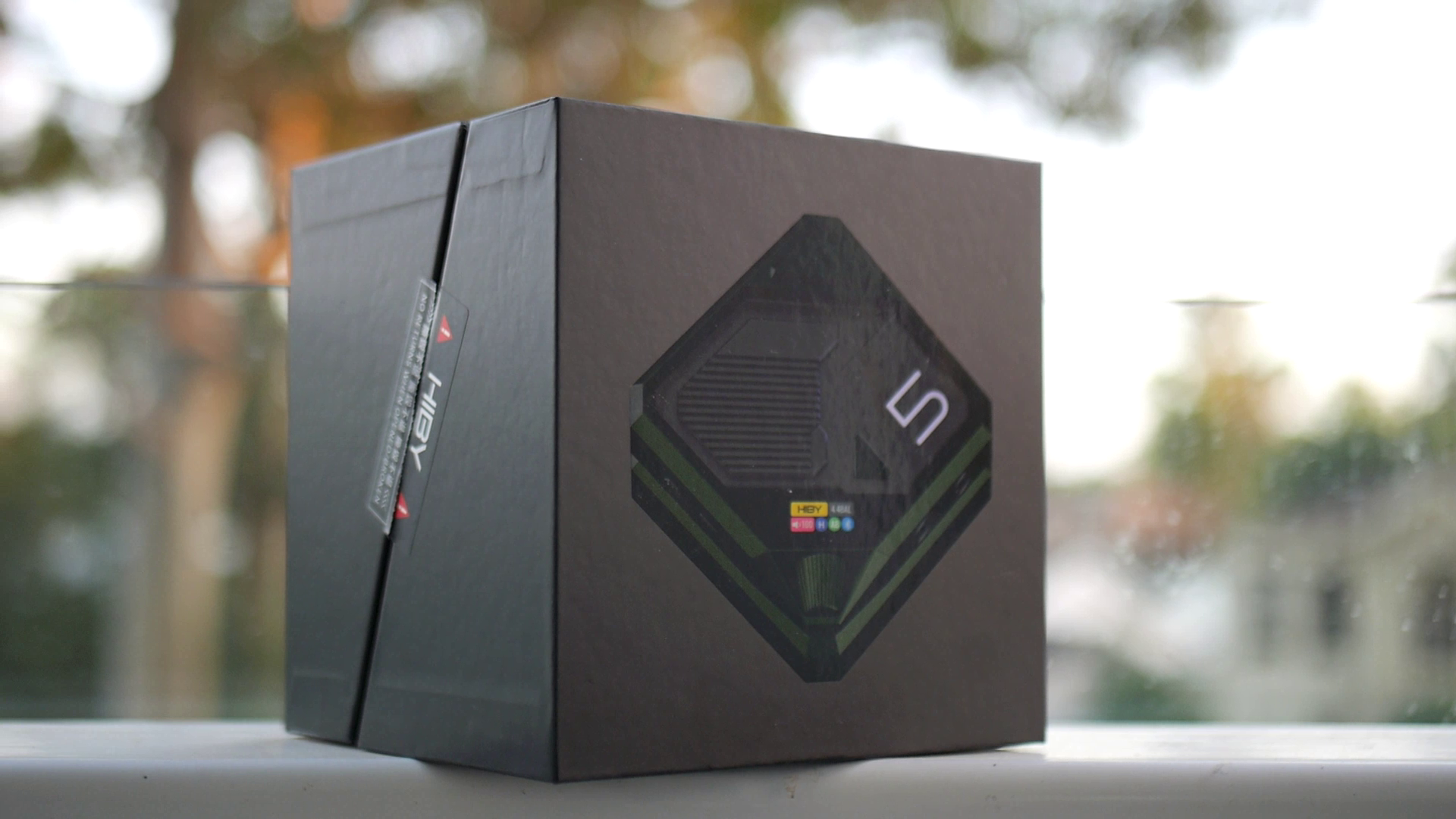
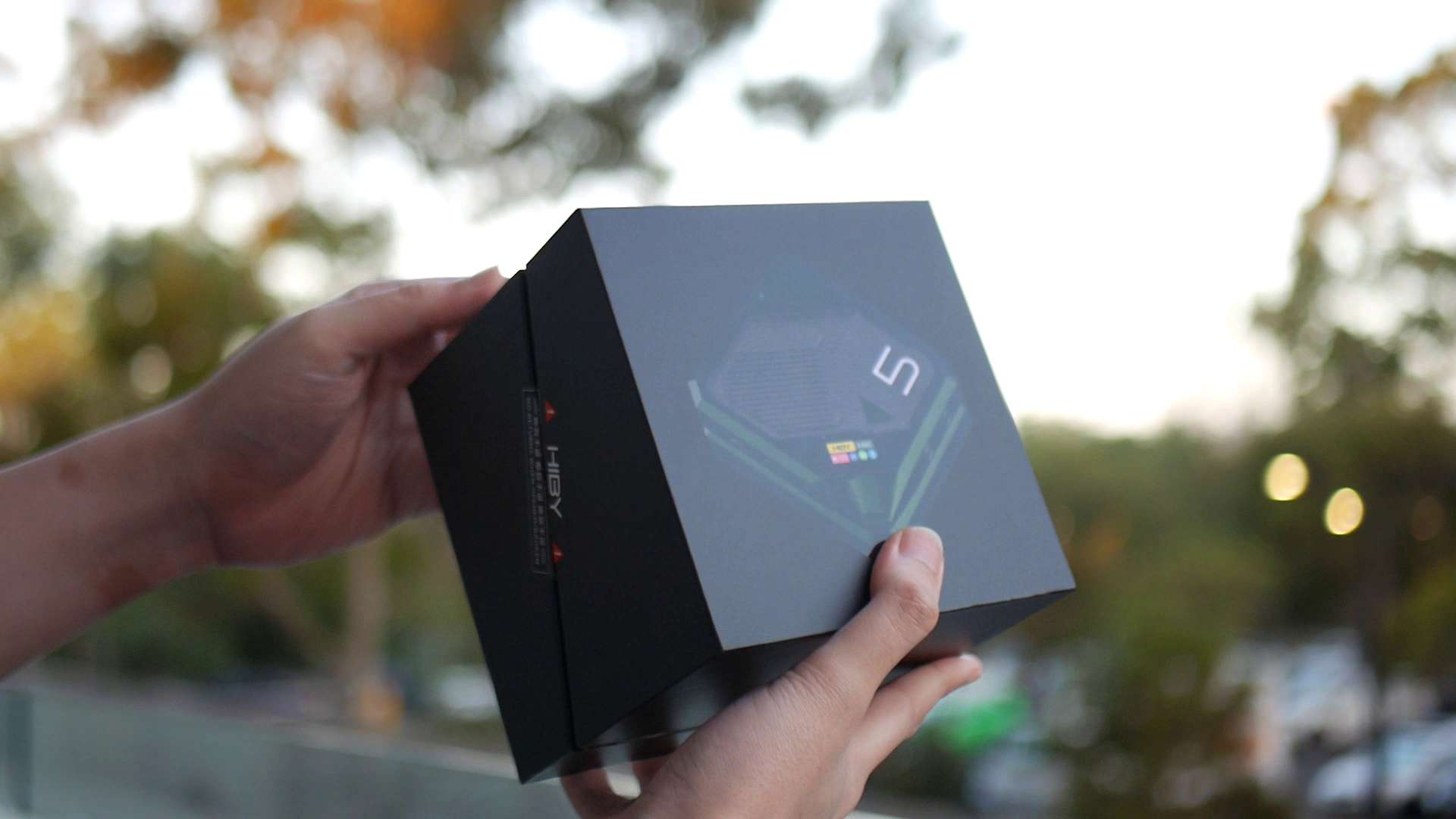

HiBy FD5 is a desktop-class DAC+amp combo device, however its inputs and outputs are more in-line with portable gears than desktop gears. FD5 receives digital signal from your phone or computer via a USB-C cable or bluetooth, converts that digital signal into analogue signal using an array of 4xAKM4493 DAC chips (operating in current mode), amplifies the analogue signal using a built-in amplifier that can operate in either class A or AB, and finally sends it to your listening devices via a 3.5mm single-ended output or 4.4mm balanced output. You can also bypass the amplifier of FD5 and uses the analogue signal from its DAC directly via the line outputs at the back of the device, available in both 3.5mm single-ended and 4.4mm balanced variants. Keen readers would notice some interesting differences in the input and output options of FD5. Firstly, familiar input options for desktop DACs such as coax and optical input are not included here. (Luckily, the ancient USB-B connector is also absent). Secondly, FD5 includes balanced line output, which is quite rare for a device at this price point. Thirdly, the line out connections are 3.5mm and 4.4mm rather than the RCA and XLR commonly used in other DACs. And finally, FD5 can act as a bluetooth receiver.
In other words, FD5 feels like a gigantic USB dongle DAC rather than the usual desktop “stacks” like Schiit Modi+Magni or Topping D90+A90.
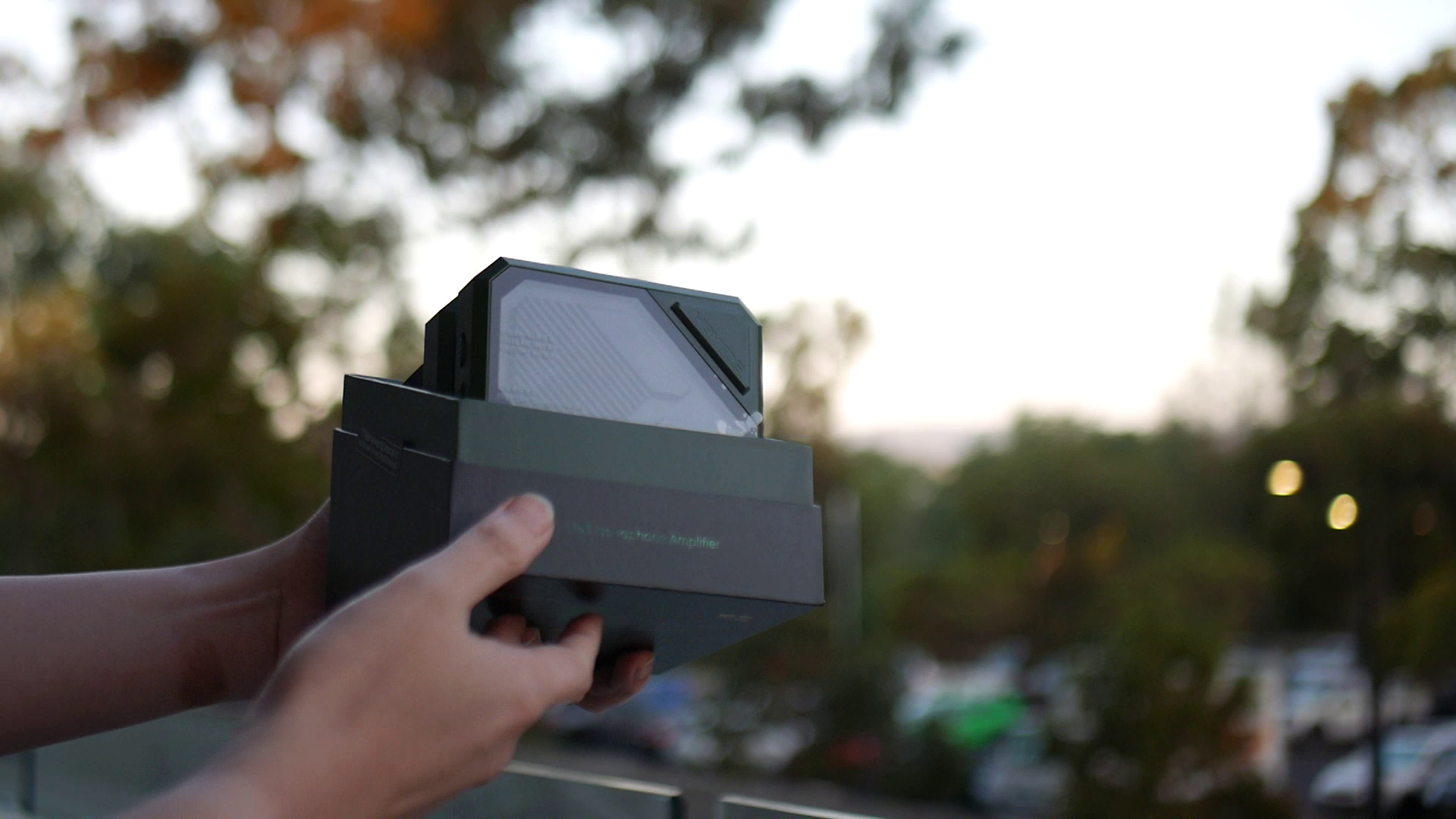
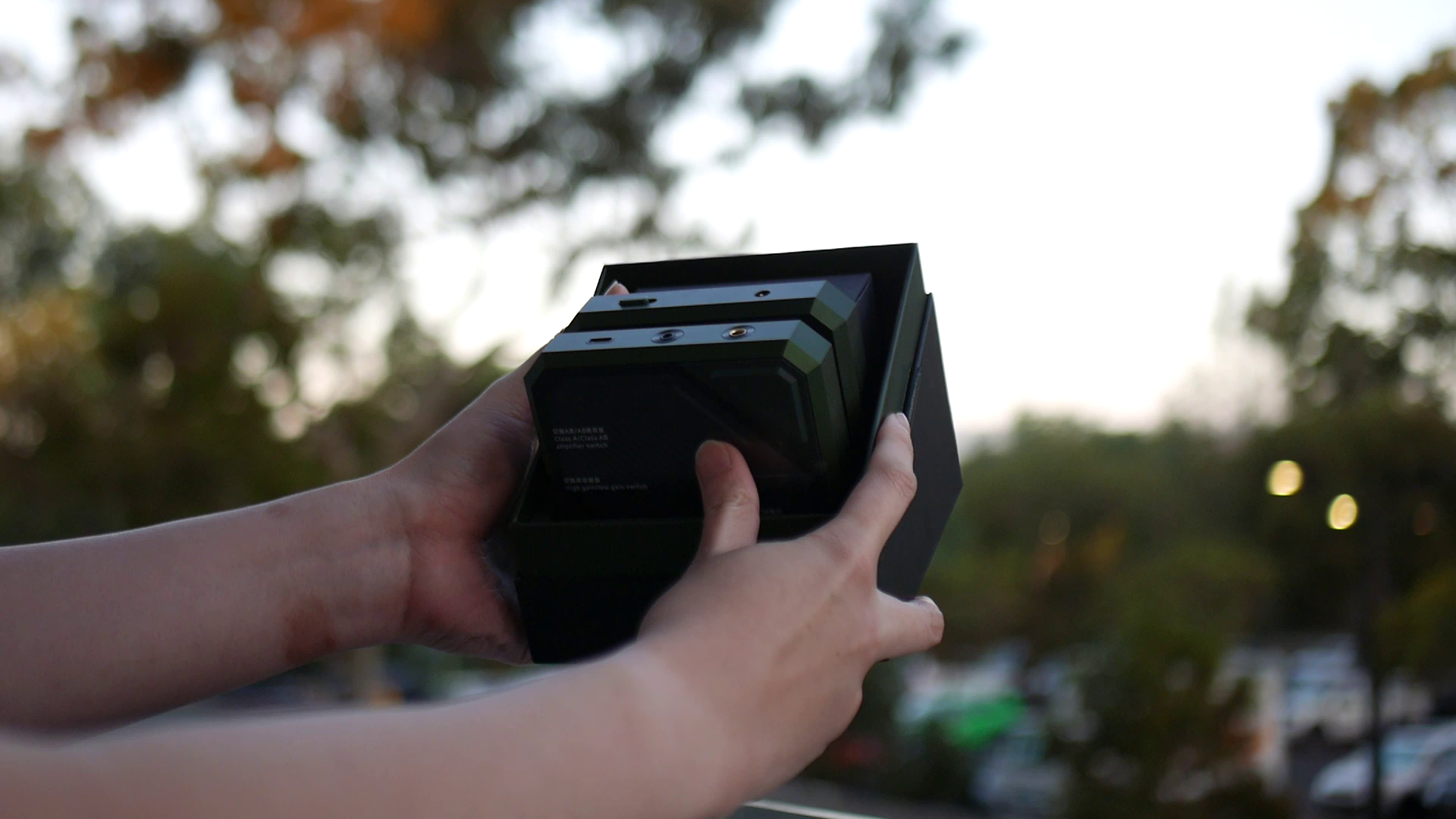
Let’s take a closer look at FD5. My first impression with this device was how dense it feels: it’s quite small but heavy. The shell of FD5 is constructed entirely from a thick aluminium alloy, save for the top panel which is constructed from thick glass. The device itself actually a stack consisting of two separated components connected via a 20-pin connector and strong magnets. The bottom layer contains the power supply circuitry, while the top layer contains the DAC, amplifier, USB and bluetooth controllers, and the display screen.
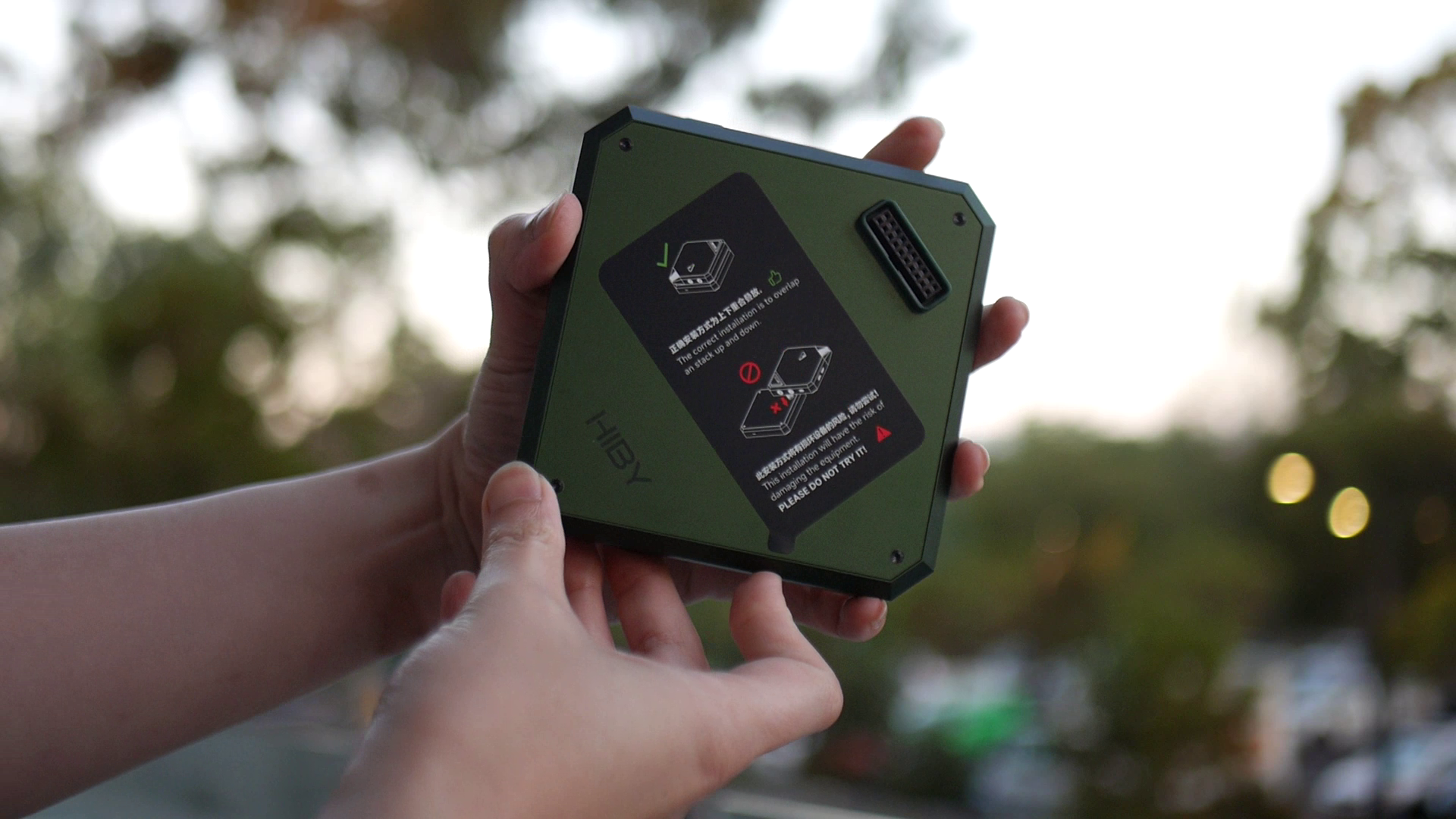
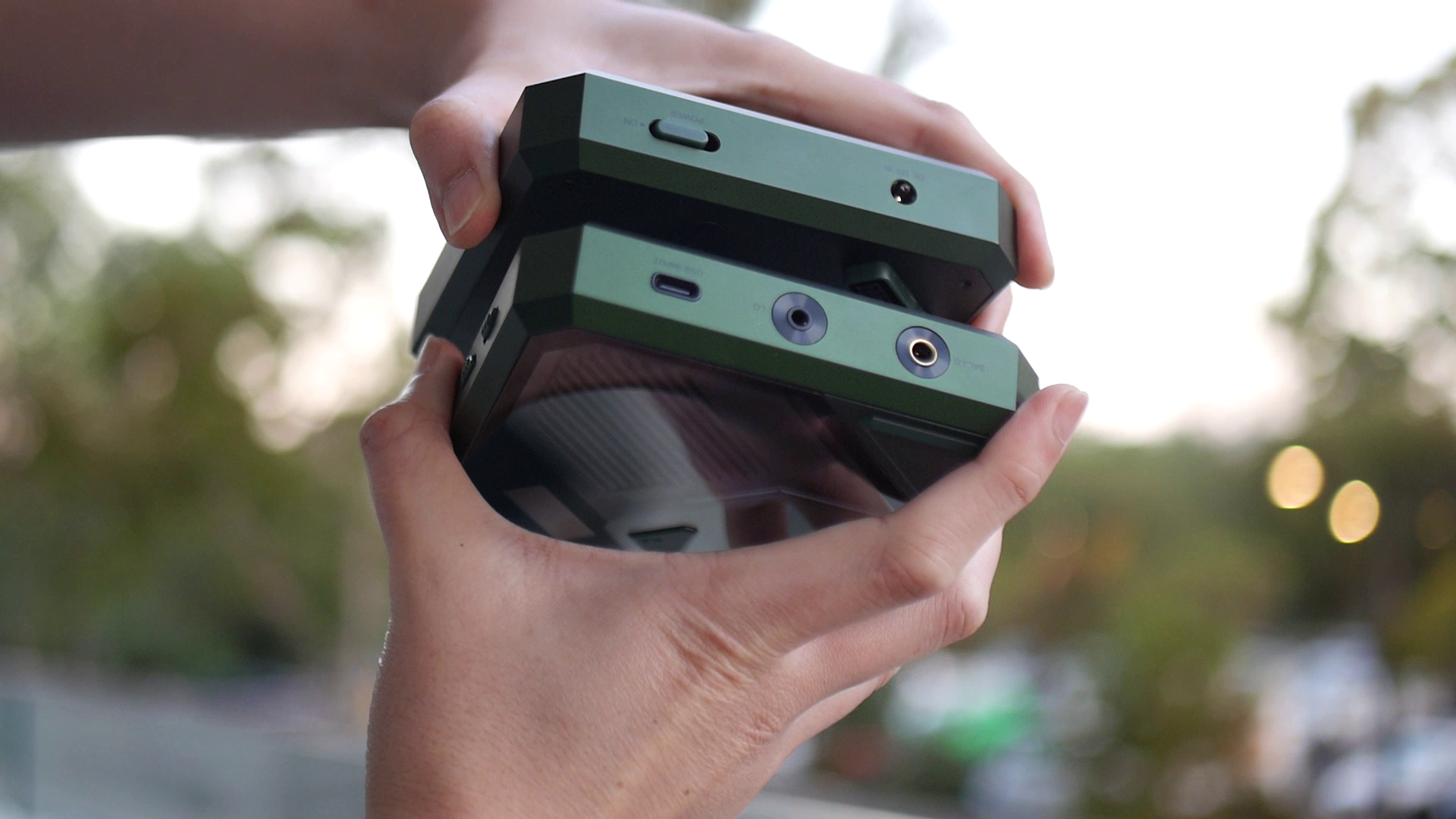
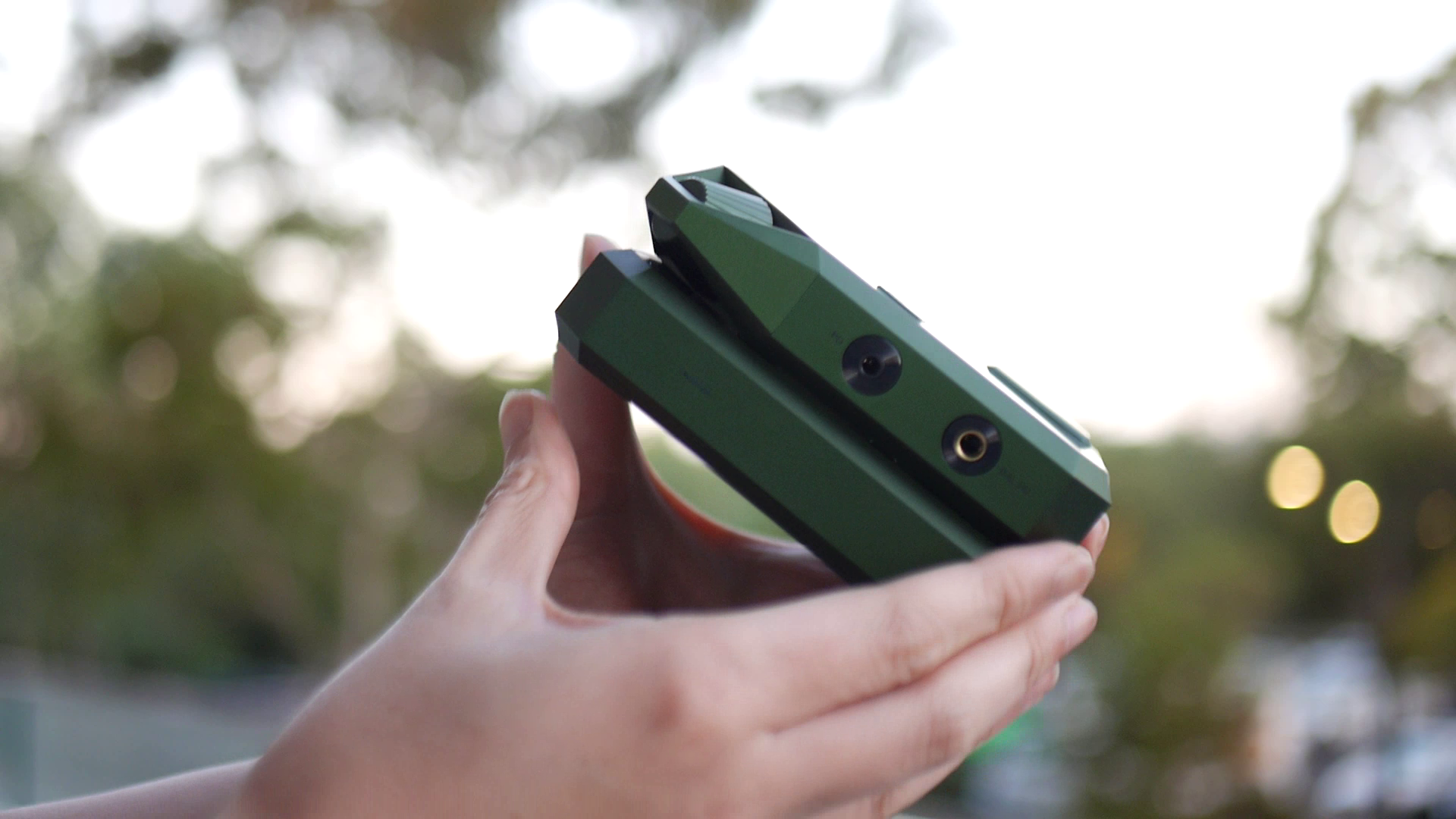
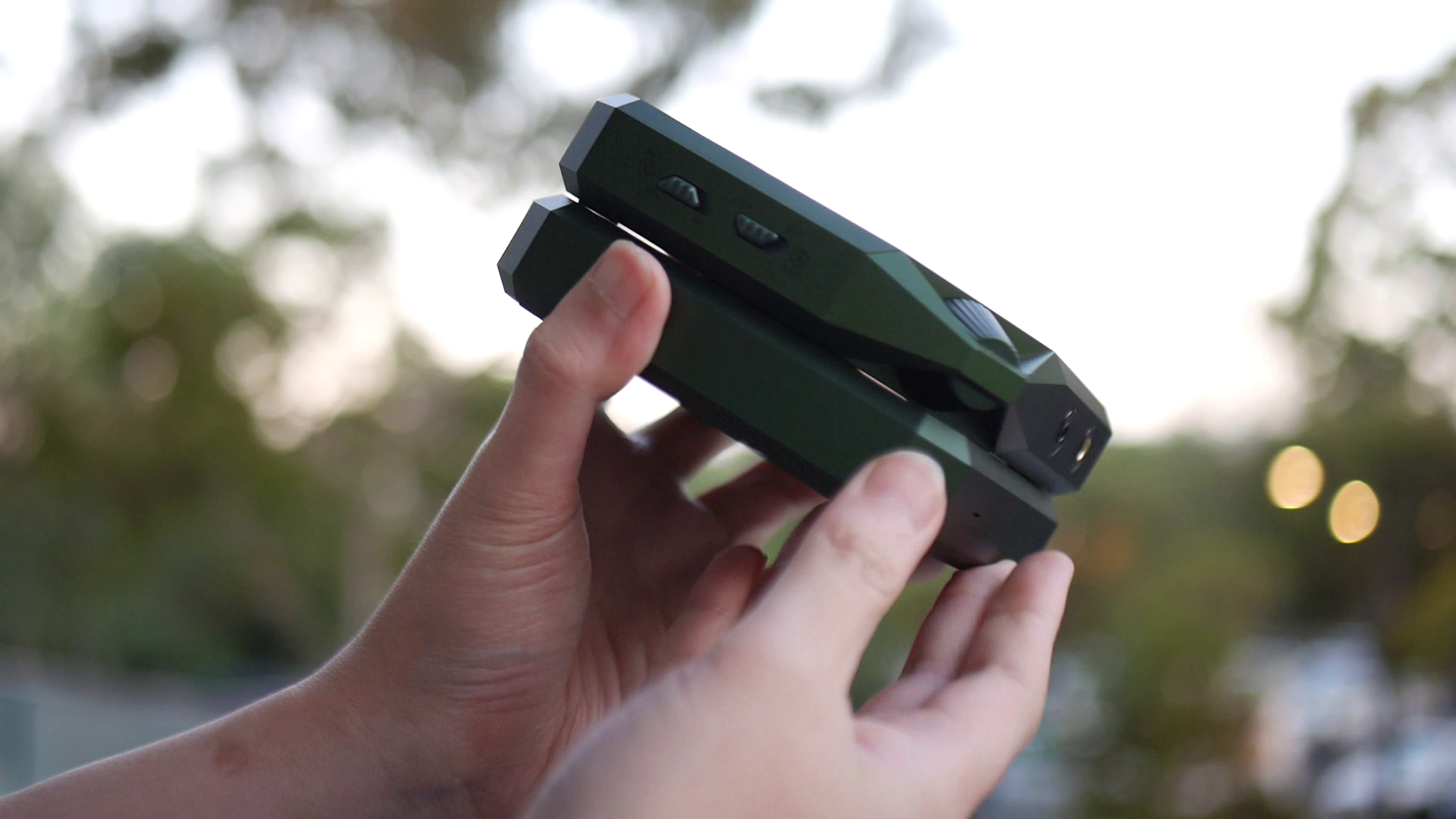
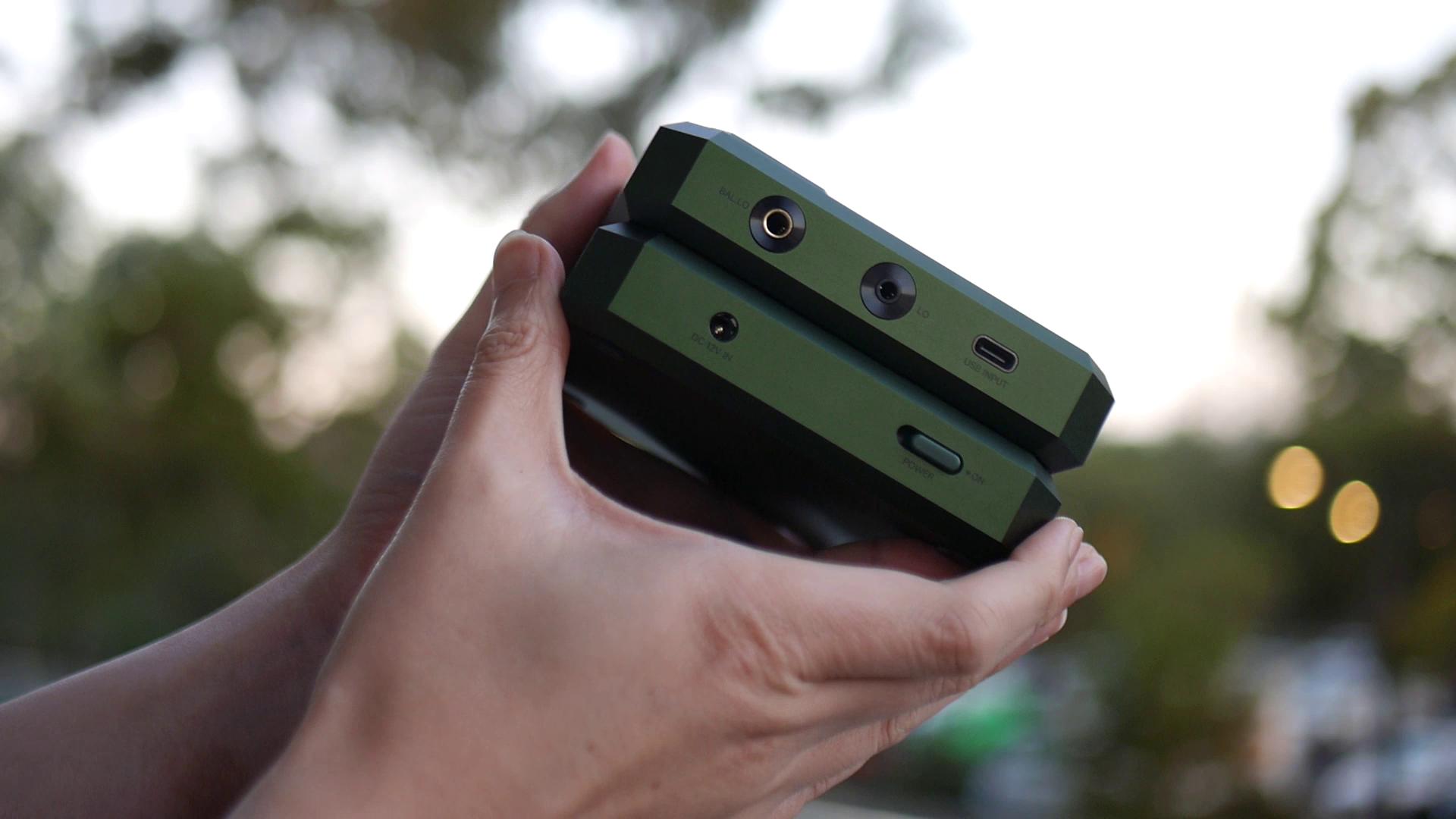
Actually, there is a third component that is usually hidden under the desk: the AC adapter that converts 240V AC from the wall plug to the 12V DC required by the power supply circuitry of FD5. And boy oh boy did HiBy supplied FD5 with a beefy adapter. This brick can output upto 60W DC (12V at 5A), even though FD5 itself only requires at most 24W. To be honest, I am a bit disappointed that FD5 still requires an external power brick, given the fact that is already contains one layer designed especially for handling power supply. Another point that HiBy could improve here is adopting USB-C power supply rather than requiring the old-school barrel plug. Had FD5 been equipped with USB-C power supply, it would have been able to be used as a transportable device, meaning I can bring this brick with me on travel and power it directly from my powerbank or my tiny 100W GnA charger. As it stands, the clunky plastic brick stands in stark contrast against the high-tech, futuristic vibe of FD5.
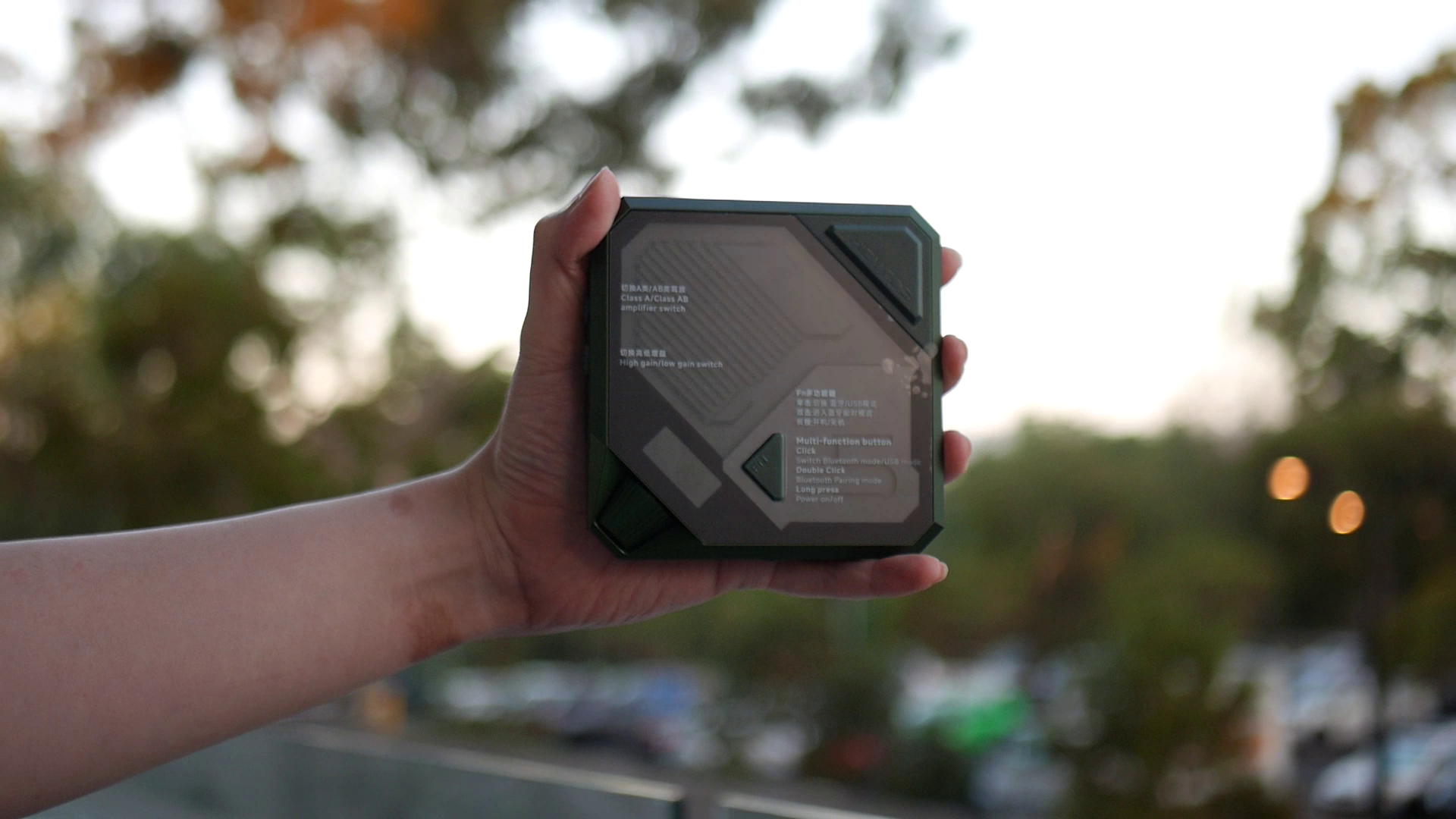
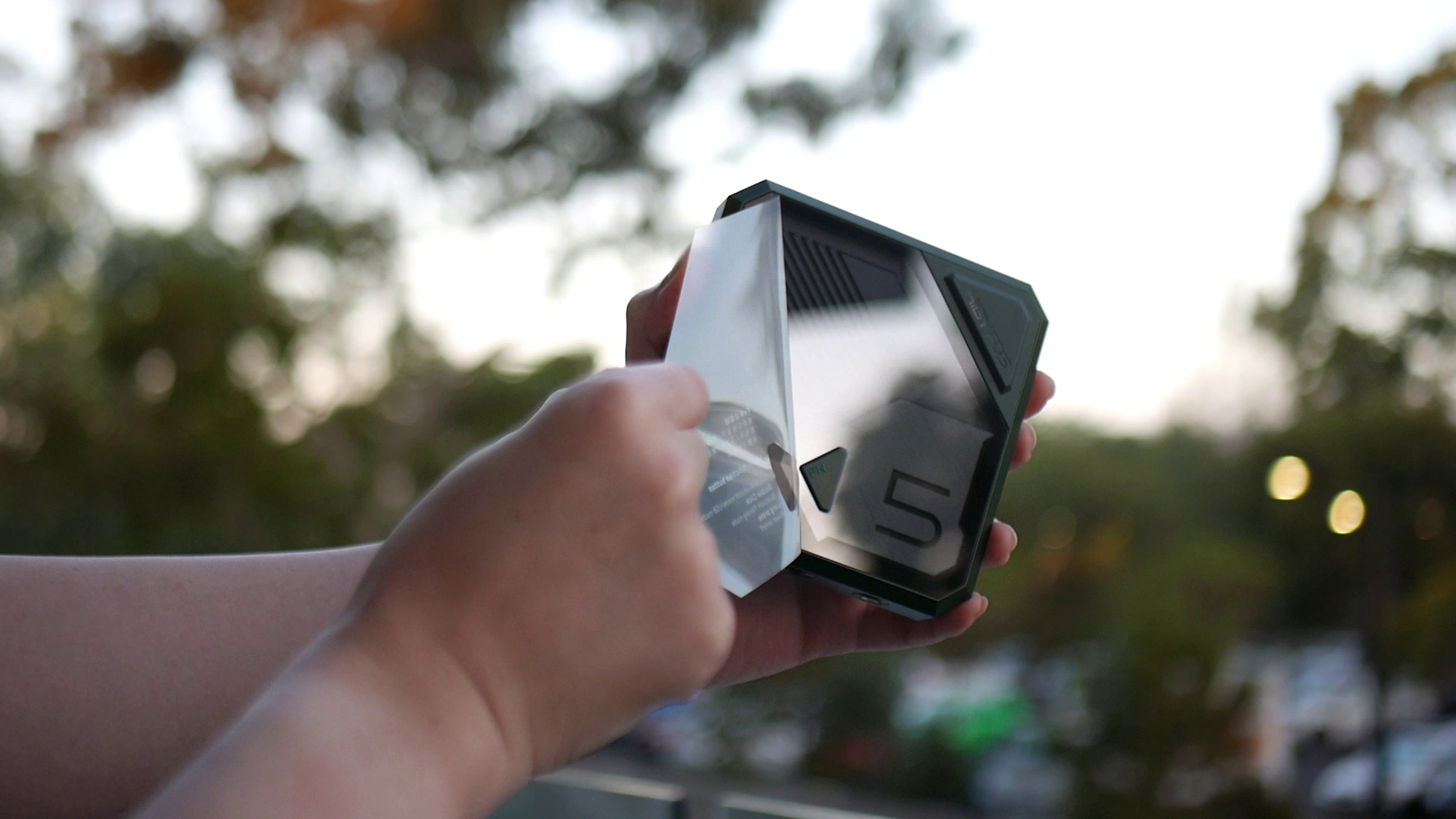
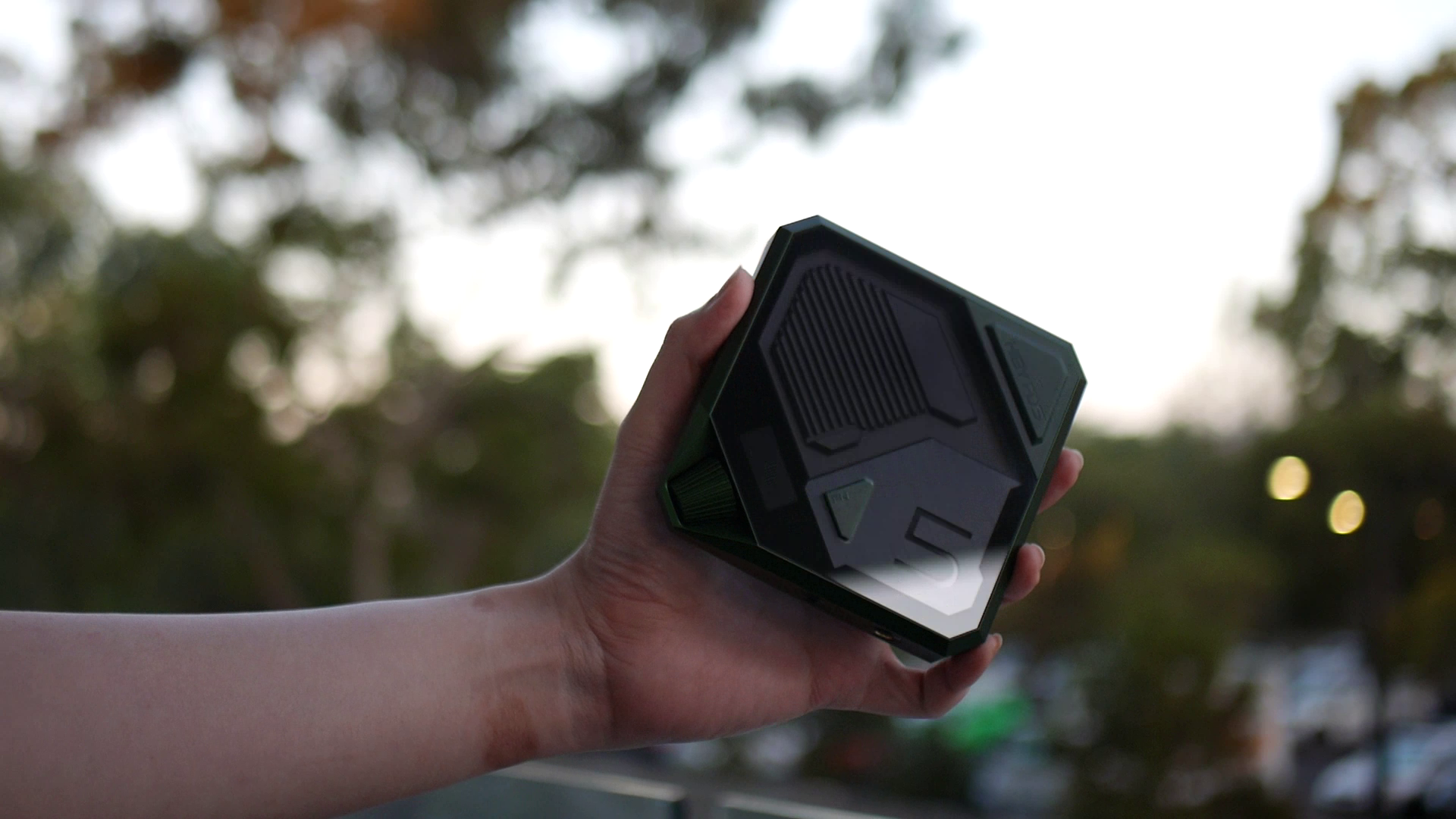
Speaking of design, I think this is one area where HiBy shines again with FD5. This device continues the retro-futuristic, cyberpunk vibe that HiBy started with R4. I particularly enjoy the design of the top plate of FD5 with the layered design elements of glasses and brushed metal, the light up “5” logo, and the OLED screen. Of course, whether a design “vibe” with you is totally subjective, and I get it if you find the design of FD5 tacky or inauthentic (e.g., they show part of the circuitry under the glass panel rather than a decorative element that pretends to be a heatsink). However, similarly to the case with R4, I appreciate the extra mile that they went with this device, when they could have gotten away with just another non-descriptive metal box and call it a day.
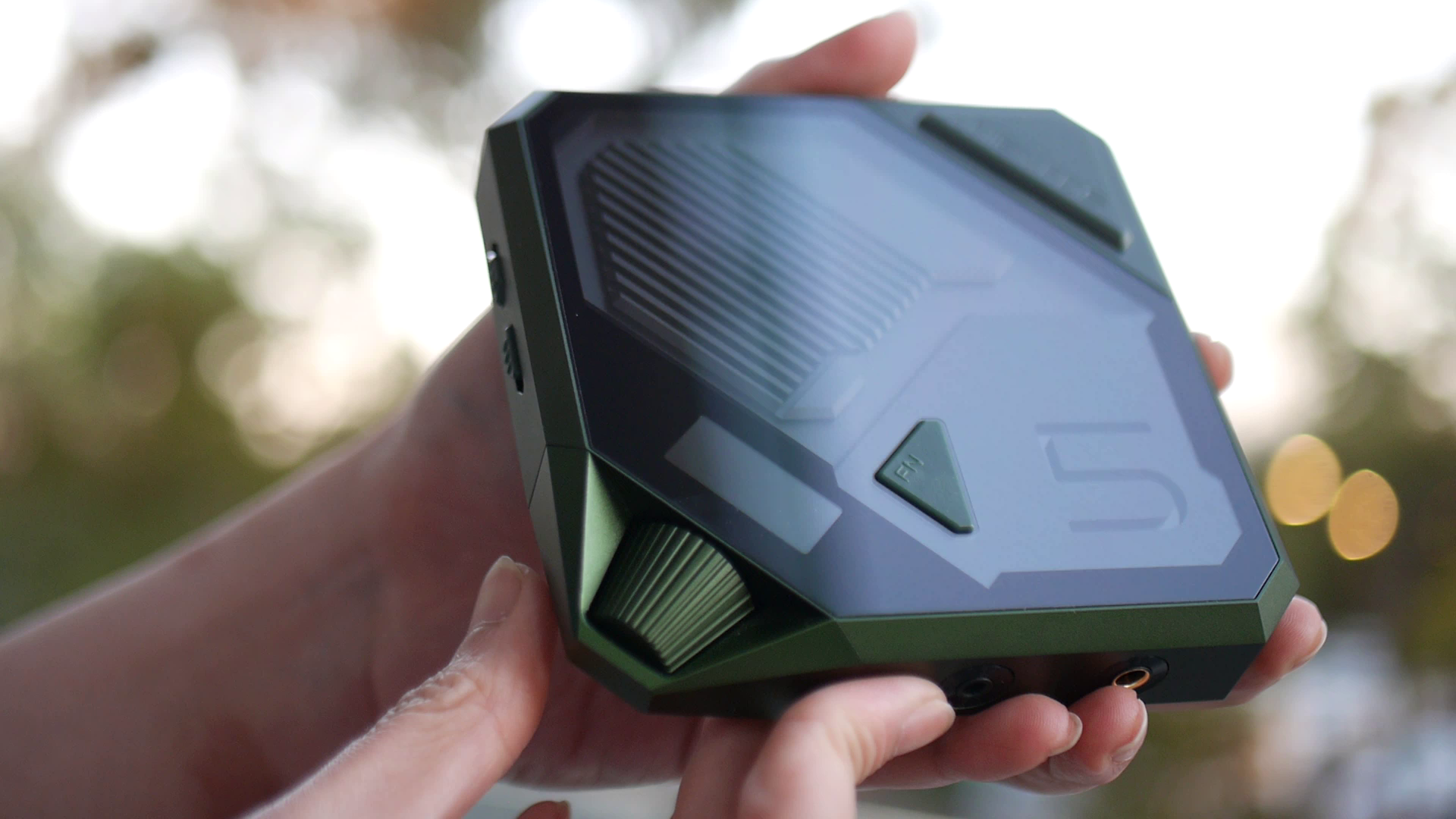
Before we move on, let’s take a tour around the device. From the top, you will find the decorative glass panel with a “Fn” button, a tiny OLED screen showing the operating mode of the device, and a digital tactile volume wheel. You can turn on and off the device with a long press on Fn button. A single press allows you to switch between USB and bluetooth mode. Double click when you are in Bluetooth mode allows you to enter pairing mode.
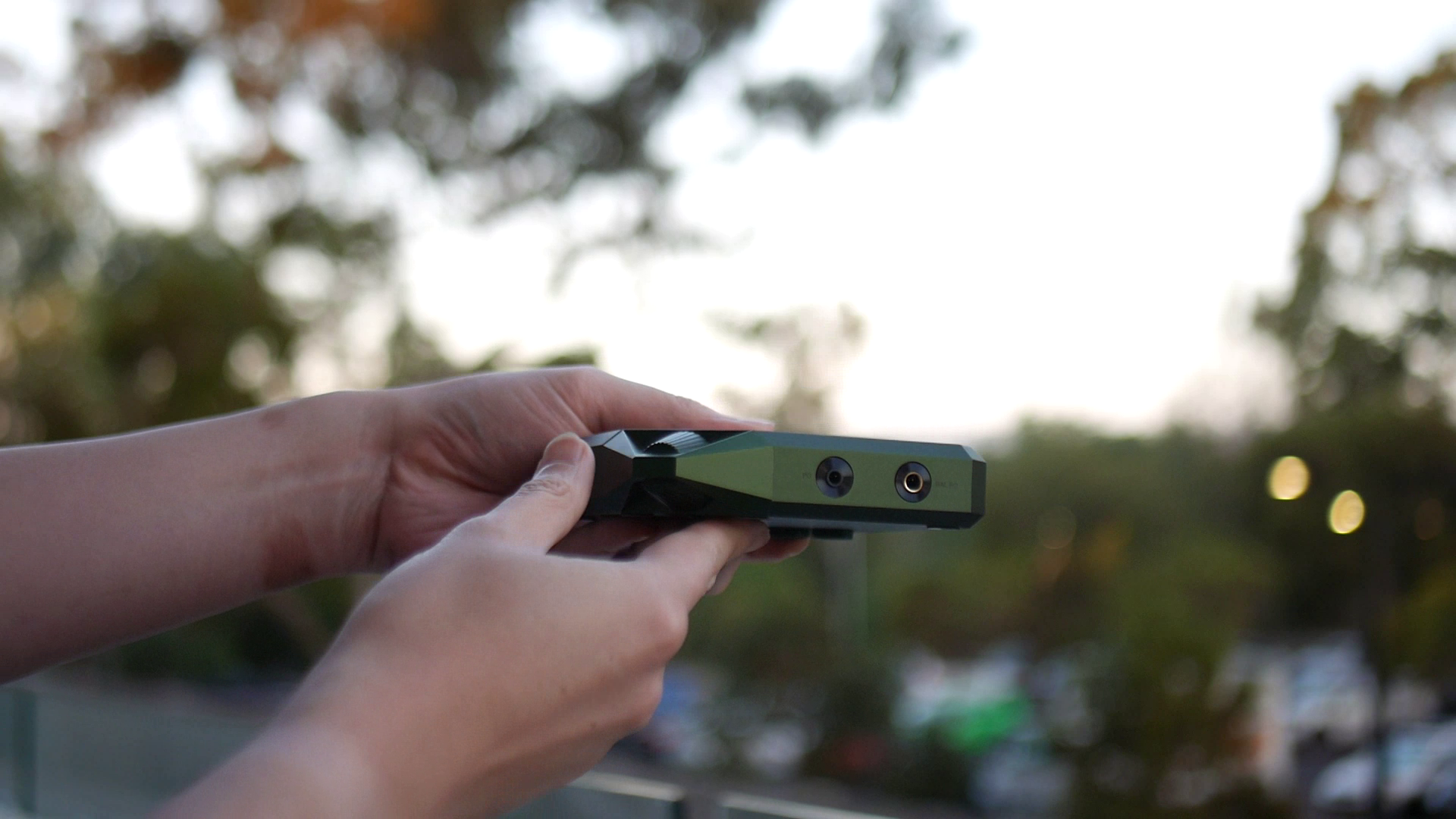
On the front of the device, you would find 3.5mm and 4.4mm headphone outputs on the top layer and a LED indicator on the bottom layer. This LED lights up when the bottom layer receives electricity.
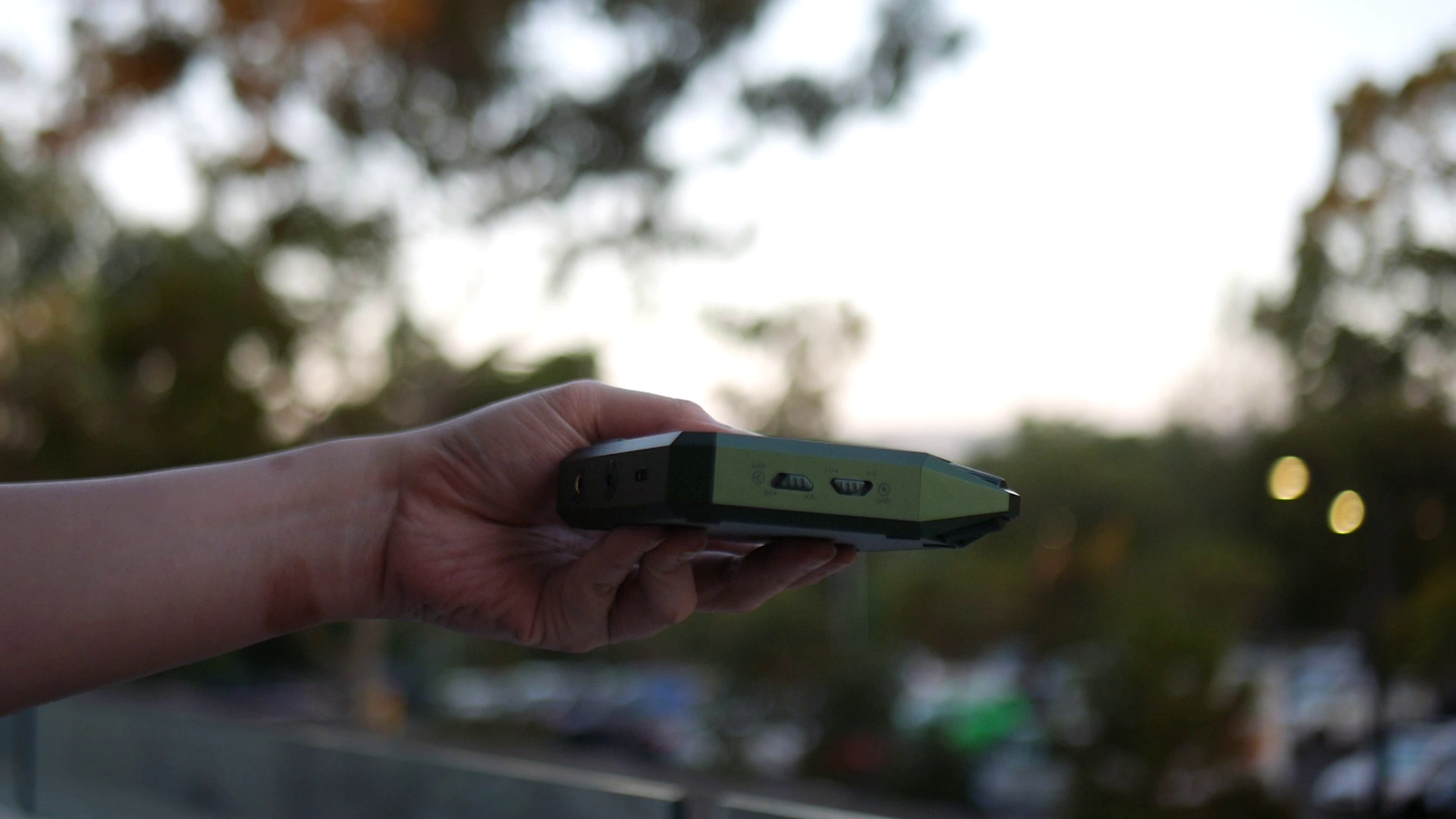
On the left hand side of the device, you would find two switches. The first one allows you to switch the amplifier between class A and class AB operating mode. The second switch allows you to change the gain from low to high. There is nothing on the right side of the device.
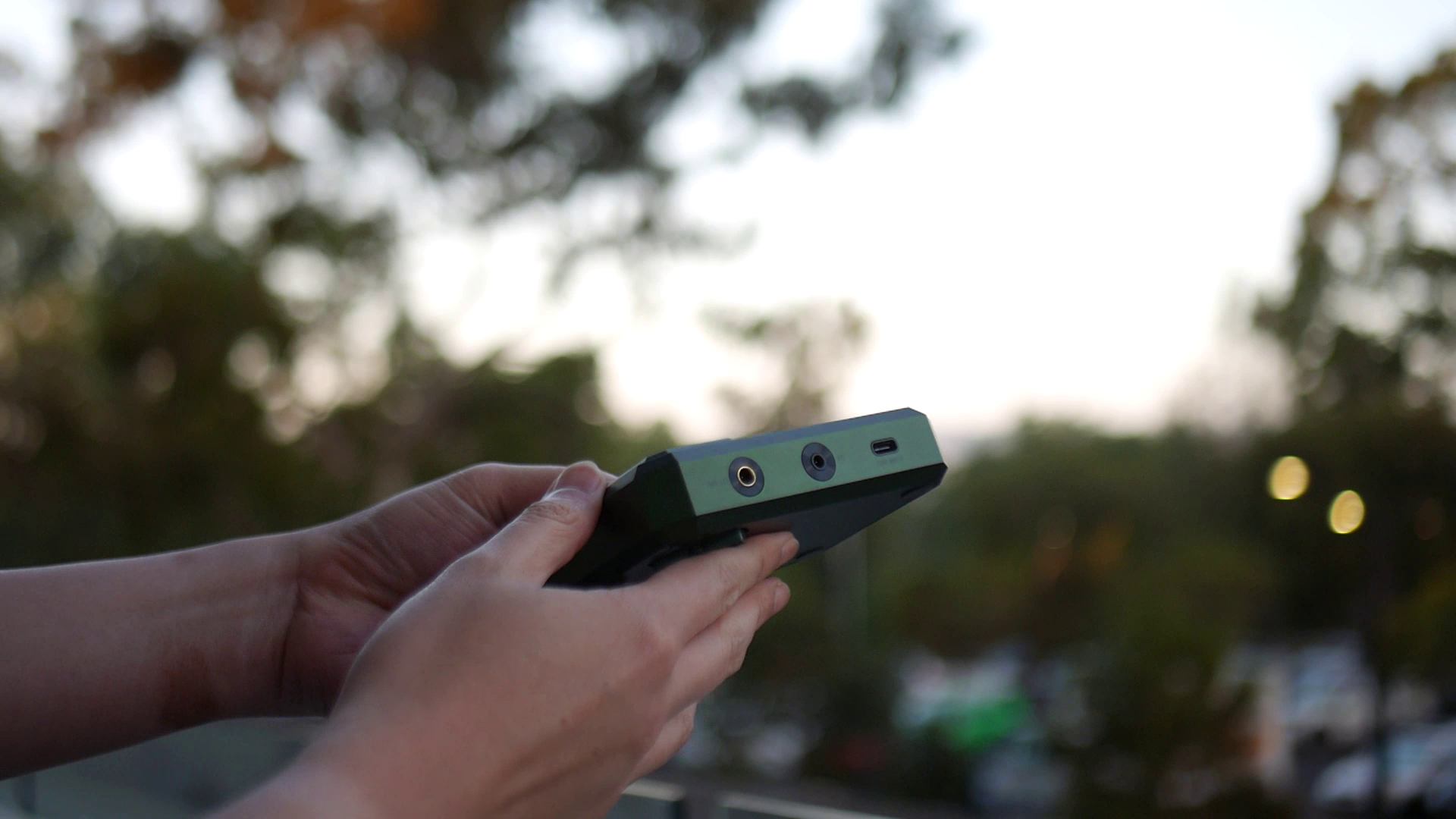
At the back of the device, you would find the 3.5mm and 4.4mm line output on the upper layer, next to the USB-C data input. On the bottom layer, you would find the 12V DC input and a power switch.
Functionality
In the last four months, this device has been connected to my desktop computer at home via a USB hub hidden under desk. I used it with both IEMs and speakers. My Creative Pebble active speakers are connected to FD5 via an aux cable connected to the 3.5mm line out at the back of the device, whilst my IEMs are connected to the 4.4mm headphone out at the front. When both outputs are connected, FD5 would only play music from the headphones output. Therefore, when I want to listen to my speakers, I simply disconnect my IEMs. I used this simple setup for music, movies, video editing, as well as gaming. I also use FD5 to output sine sweeps signals to measure IEMs. It performs well without any unexpected quirks or hiccups. Just for the record, I use Linux on my desktop (Arch, btw), which could lead to nasty compatibility issues. Yet, FD5 pairs with my computer immediately out of the box with zero problem. It’s hard to say whether HiBy software engineering team, the Linux kernel developers, or Pipewire developers deserve the credit for this seamless compatibility, but I’m glad that it works.
There are two aspects of FD5’s functionality in USB mode that HiBy does an outstanding job and deserves more highlight, in my opinion. The first one is the volume control. HiBy makes a very sensible choice of not ramping up the gain level too quickly, meaning I have a wide range of volume adjustment even when I pair FD5 with highly sensitive IEMs. In other words, I never have the fear that if I touch the volume wheel incorrectly, I will blow my ears out like some smaller USB dongles.
The second highlight of FD5 is that it does not make random loud “POP” when the music stream stops, such as the moment between songs. It is the case with both headphone outputs and line outputs, from both single-ended and balanced connectors. You might think that it is such a minute thing. However, with sensitive IEMs, the pops can get quite loud and unsettling.
Before we move on, let’s briefly talk about the Bluetooth receiver function of FD5. I have to admit that I couldn’t find any practical use case for it myself. However, I’m happy to report that the latency is kept to a minimum, meaning it is possible to watch videos and play casual games. Other use cases that are sensitive to audio latency are still best served with a wired connection.
Sonic Performance
Note: Comparisons in this section were based on A/B tests where participating devices were volume-matched to 73dB with a coupler using pink noise. Unless mentioned otherwise, AFUL Cantor was used as the IEM in the comparisons.
Before we talk about the sonic performance of FD5, it’s important to talk about its ability to switch between class A and class AB, which is quite an impact on the sound signature of FD5. Simply put, class AB sounds crisper, as if every elements on the soundstage has more precise “size” and positioning. However, the soundstage in class AB feels smaller and more in-the-head. Class A mode of FD5 creates the opposite effect: every elements in the mix feel a bit smoother and somewhat less precise, but the soundstage feels larger and more enveloping. This difference is quite easy to spot with more spacious tracks such as Shadow of Baar Dau, if you pay attention to the female voice in the background. Class AB makes the voice sharper and “nearer”, whilst class A sounds more “atmospheric” and immersive. The difference is not day-and-night like when you flip on an EQ profile. However, it is the small things, like the rendition of the background vocals that I described, combined together over the course of many songs that completely changed how I feel and engage with the content. Your preference would determine whether A or AB is better. Personally, I think my IEMs sound better with Class A amplifier of FD5. The rest of this discussion about sonic performance of FD5 would be based on Class A.
In Class A mode, the sound of FD5 can be described as large, enveloping, powerful, and somewhat analogue. The “large” and “enveloping” subjective impressions of the FD5 is readily expressed in recordings with a strong sense of space and atmosphere, such as the OST album of The Elder Scrolls Online that I linked above. Simply put, if a recording is mixed to convey a sphere of sound around you, FD5 would be able to convey that sensation as well as you would expected from a desktop-class device. It should be noted that FD5 does not do any DSP shenanigans behind the scene, so if a recording places the phantom center of the soundstage (e.g., where the singer usually stands) upfront, inside your head, FD5 would not try to bring the center out to the front of your face. If that sorts of “large” soundstage you are looking for, you need to use DSP rather than changing a DAC or amplifier.
The “somewhat analogue” aspect of FD5 seems to stem from the Class A amplifier. By “analogue”, I mean FD5 does not present the mix in an edgy or harsh way. Instead, all the transients (e.g., note attacks) as well as the placement of sound elements on the soundstage has a “softened” sensation. I use the term “somewhat” here because FD5 does not goes all the way in making the sound hazy or warm. It’s just not extremely snappy or edgy. This presentation has pros and cons. The pros side is easy to see: a more atmospheric and easy-going impression that suits longer listening session. The cons is that FD5 does not feel particularly precise or detailed, especially when I compare it to some digital audio players (DAPs) with strong detail retrieval. Just to be clear, I’m not saying that FD5 sounds blurry or mushy or lacks details. It’s simply not a super crisp and detailed DAC+amp combo.
One aspect where FD5 does surprisingly well is the bass, particularly subbass. I was caught off-guard by the subbass a quite a few times when listening to some familiar tracks in my library or watching some old videos, didn’t realise these content actually has a pronounced subbass element. The quality of the bass, reflected by the details and the perceived “textures” in the bass notes and subbass rumbles, is also very good with FD5. That said, due to the “somewhat analogue” presentation of FD5, this device does not feel particularly bass boosted or overtly dynamic. Instead, it always feel “lowkey” but authoritative when needed.
Pairing with Special IEMs: FD5 works okay with sensitive IEMs. When the music plays, I couldn’t hear the background hissing noise with sensitive IEMs like AFUL Performer5+2 or HiBy Yacht10. However, ultra-sensitive IEMs like Campfire Audio Andromeda 2020 will reveal a faint hissing noise that’s constantly in the background, which reminds me of watching old TVs. My brain filters out that noise quickly, but it’s always there. On the plus side, there is no problem with FD5 getting overly loud when driving Andromeda, which is great. Andromeda also benefits from the powerful bass presentation of FD5, so I can live with the hiss.
On the opposite end of the spectrum, FD5 has no problem handling IEMs and earbuds with high impedance or ultra-low sensitivity. It drives the notorious Final Audio E5000 with authority, creating a thick and controlled bass line and great sense of depth. Sennheiser HD560S also sounds quite decent with FD5 thanks to the slightly better bass and the “somewhat analogue” presentation.
Comparisons:
- HiBy R3II (Micro DAP): Despite having the “somewhat analogue” characteristic, FD5 still comfortably out-does R3II in terms of the sense of clarity and precision of the presentation of sonic elements in the mix. Another noticeable difference between FD5 and R3II is the bass, particularly the subbass. Simply put, FD5 rumbles more and its bass lines are more controlled and refined in direct comparison against R3II. Perhaps thanks to the better bass response, music also sounds like they have more near-to-far perception (a.k.a., “depth”) compared to R3II.
- L&P W4 (High-end USB DAC): This comparison is perhaps the most critical one for FD5. Surprisingly, the result was more one-sided than I expected: FD5 comfortably outshines W4 due to the way it handles bass. For instance, when I listen to Shadow of Baar Dau, the way FD5 makes the bass line rumbles lends a sense of power and atmosphere to the track. Meanwhile, W4 feels flat and lifeless in comparison as it cannot do the bass like FD5. As a result, even though W4 might be more detailed and precise, I find the sense of power conveyed by FD5 a worthy trade-off.
- HiBy R6 Pro Max (High-end DAP): I found the FD5 and R6 Pro Max trade blows in soundstage size. FD5’s stage is slightly larger and more open. The perceived bass power is similar, but FD5 lacks the incisiveness of transients, resulting in a less pitch black background and more “analog” sounding presentation. In other words, FD5 is more about rumble and an analogue sensation, whilst R6 Pro Max has an upper hand in terms of the punchiness and dynamic. R6 Pro Max also sounds more precise and more detailed than FD5. Since my preference leans towards resolution, precision, and dynamic, I prefer R6 Pro Max in this comparison, but your preference might lean towards the analogue and powerful sound of FD5 might be more suitable.
Concluding Remarks
Should you get a desktop setup if you primarily listen to IEM? Let’s face it, most IEMs use a tiny amount of power, thus can get more than loud enough even with the humble Apple dongle. So, the strictest sense, you don’t need a desktop setup. However, you might want a desktop setup because some IEMs, particularly the less sensitive ones, just sound grander when driven by a nice desktop setup. If you decide to go down this path, you would undoubtedly run into problems such as the lack of the suitable balanced output from desktop amplifier, hissing noise even with less sensitive IEMs, too loud volume even at the lowest volume level, so on and so forth. FD5 belongs to a small class of desktop setup that side steps most of these problems, making it a good choice for IEM listeners. If this use case speaks to you, FD5 receives a recommendation from this reviewer.
What I like about this device:
- Design, machining, and build quality
- The sense of power coming from strong and controlled subbass
- The sense of space and envelopment with most recordings
- Two sound signatures within one package
- Minimal delay in Bluetooth mode
- The volume adjustment can go low enough to support sensitive IEMs
- Price
What could be improved:
- Still use barrel plug instead of USB-C for power supply
- Could be a bit more crisp and resolving

